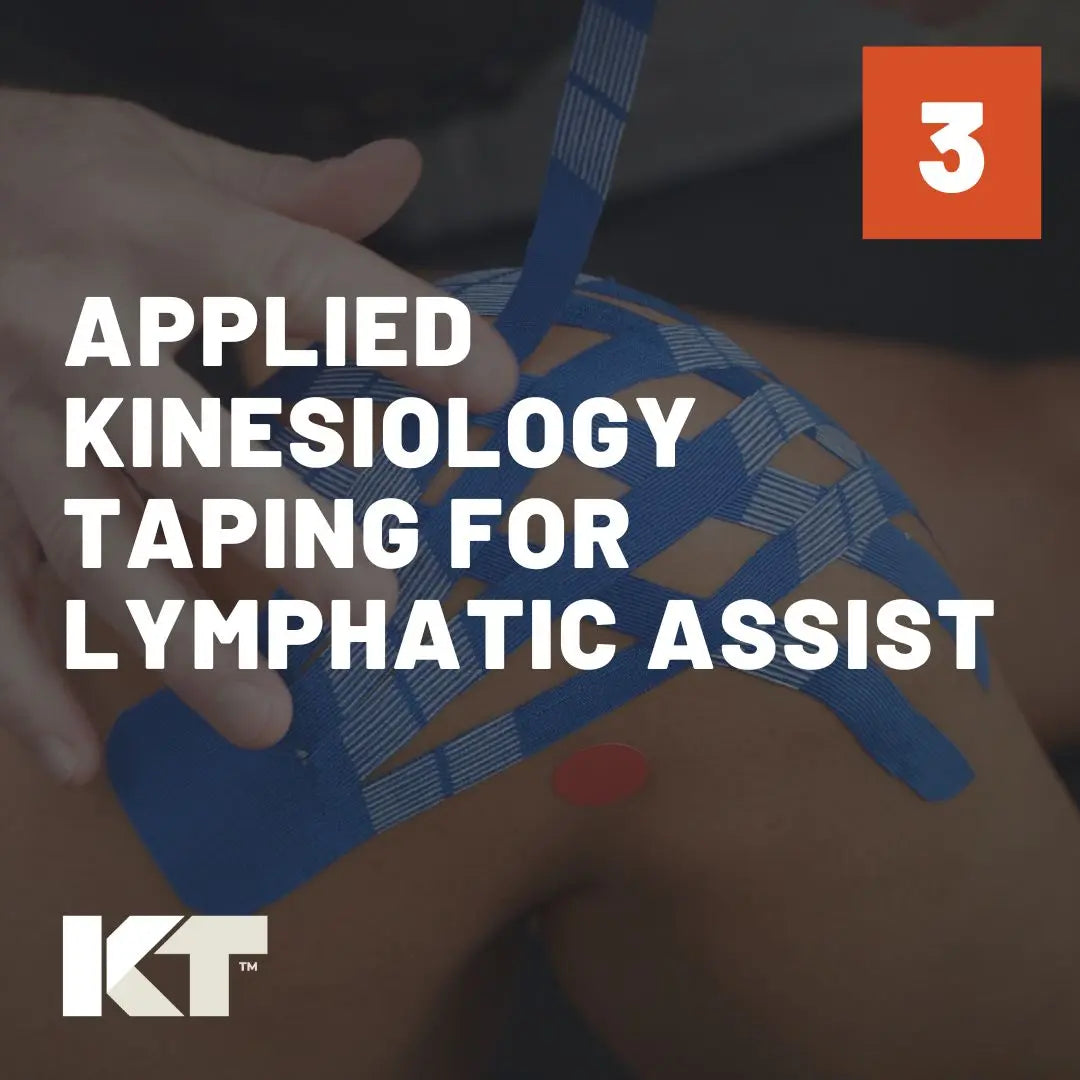Lymphatic Taping for Lymphedema: How It Works and When to Use It
When most people hear “taping” they think of athletes or sports injuries. But taping isn’t just for strained muscles or sprained ankles. In recent years, a gentle, specialized form called lymphatic taping has gained attention for its role in managing swelling, particularly for individuals living with lymphedema or chronic lymphatic issues.
If you or someone you love deals with persistent swelling, be that from surgery, cancer treatment, or a lymphatic disorder, you know how frustrating and uncomfortable it can be. That’s where lymphatic taping comes into the picture. This non-invasive technique offers a way to support your body’s lymph flow, reduce swelling, and help restore comfort to daily life.
In this article, we’ll explore how lymphatic taping works, when to use it, and what to expect from this gentle yet powerful tool. While we’ll explore the topic generally, these are more specific and complex techniques that may best be accessed and applied with the help of a trained medical professional. If you are a medical professional looking to incorporate these techniques, we recommend the in depth training available through KT’s Continuing Education Course 3 - Applied Kinesiology Taping for Lymphatic Assist.
What Is Lymphatic Taping?
Lymphatic taping, sometimes called lymphatic drainage taping or lymphatic kinesio taping, is a specialized technique that helps support the natural function of the lymphatic system. While it uses the same stretchy, breathable tape you might see on an athlete’s shoulder or knee, the application method is very different.
Unlike traditional taping, which often aims to stabilize joints or muscles, lymphatic taping focuses on skin and superficial tissues. The tape is typically cut into fan-shaped strips and applied with minimal tension directly over swollen or congested areas. This design gently lifts the skin, creating microscopic space beneath the surface, which allows lymph fluid to flow more freely into nearby functioning lymph vessels.
The technique is rooted in principles developed by the Kinesio Taping method but specifically adapted to address issues related to swelling, lymph flow, and congestion. Many individuals use it alongside other therapies such as compression garments, manual lymphatic drainage, or exercise, as part of a comprehensive swelling management plan.
How Lymphatic Taping Works
The lymphatic system is a network of vessels and nodes responsible for clearing waste, toxins, and excess fluid from our tissues. When this system becomes impaired—due to surgery, radiation, trauma, or certain medical conditions—it can lead to a buildup of lymph fluid known as lymphedema. This often results in uncomfortable swelling, limited mobility, and even skin changes.
Lymphatic taping works by applying a very light mechanical lift to the skin. That lift decompresses the superficial lymphatic capillaries, allowing stagnant fluid to move into open, healthy lymphatic vessels. Over time, this may help reduce pressure, pain, and visible swelling.
Improving microcirculation and assisting lymphatic return, the tape helps redirect fluid toward functioning lymph nodes. This can be especially useful after surgeries where lymph nodes have been removed or damaged, like after breast cancer procedures. The technique may also bring relief to those dealing with chronic venous insufficiency-related edema, post-radiation swelling, or other forms of chronic swelling.
In fact, research supports its effectiveness. In one study conducted by the Medical University of Lublin, Poland, 82 patients were monitored for postoperative edema treatment. Of the participants, 42 received lymphatic taping with KT Tape. The study concluded that the spread of subcutaneous tissue edema after KT application was significantly reduced.

When and Where to Use Lymphatic Taping
Lymphatic taping can be helpful for a wide range of individuals. While lymphedema remains one of the most common reasons to explore this therapy, it isn’t the only one. You should consult a medical professional prior to undertaking lymphatic taping related to these serious medical conditions. You might consider asking your medical professional about lymphatic taping if you're managing:
-
Primary or secondary lymphedema (especially in the arms and legs)
-
Post-operative swelling, such as after mastectomy, orthopedic surgery, or cosmetic procedures
-
Radiation-related swelling
-
Edema caused by chronic venous insufficiency
Common taping areas include arms, legs, abdomen, chest, face, and specific post-surgery areas such as post-mastectomy chest walls. That said, lymphatic taping isn’t right for everyone. It should not be used if you have an active infection, untreated deep vein thrombosis (DVT), congestive heart failure, or open wounds. In these and similar cases, professional medical evaluation is essential before starting any taping routine.
How to Apply Lymphatic Tape: Step-by-Step
While the taping process may look simple, applying lymphatic drainage taping technique correctly takes a bit of practice and ideally, some professional guidance. Here's a basic overview:
-
Cut the tape into fan-shaped strips. These multiple thin strips create a gentle, even lifting effect across the swollen area.
-
Anchor the tape near functioning lymph nodes. For example, if you're working on arm swelling, you might anchor the base near the armpit.
-
Apply the tape over the swollen area while it is on-stretch. Tape stretch should be minimal (often 0-10% stretch), as too much tension can actually inhibit fluid movement.
-
Prepare the skin properly. Ensure the area is clean, dry, and shaved if necessary for better adhesion.
-
Wear for 3–5 days. The tape is water-resistant and can stay in place through normal daily activities, including showers.
If you're interested in trying this at home, KT Tape offers excellent visual resources and step-by-step guides. You can even explore their recovery patch products, designed specifically to support swelling and recovery processes by simplifying the application.
Does Lymphatic Taping Really Work for Lymphedema?
This is one of the most common questions people ask, and it’s a fair one. The short answer is: yes — for many people, lymphatic taping can provide meaningful support.
Studies like the one from the Medical University of Lublin demonstrate measurable improvements in swelling reduction. Patients often report improved comfort, reduced tightness, and better joint mobility. However, it's important to view taping as complementary rather than standalone. Combining lymphatic taping with compression garments, light exercise, and manual lymphatic drainage often delivers the best results.
How Often Should You Use Lymphatic Tape?
Generally, lymphatic tape can be worn for 3 to 5 days before being replaced. The frequency of application depends on your swelling pattern, comfort, and the advice of your healthcare provider. Some individuals may benefit from continuous taping cycles, while others might use it as needed during flare-ups or post-surgery recovery.
In more complex or chronic cases, your physiotherapist, occupational therapist, or certified lymphedema specialist can develop a personalized taping schedule. Always remember: when in doubt, consult a professional!
Can You Use Lymphatic Tape After Surgery?
Any post-surgery taping should be done in consultation with your healthcare provider, however this is one of the primary reasons people seek out lymphatic taping. After surgeries that disrupt lymph nodes, such as mastectomy or lymph node dissection, patients often experience long-term swelling. Taping can gently assist the lymphatic system as it adjusts, while reducing tension and discomfort during the healing phase.
Of course, you should always get clearance from your surgical team before applying tape post-operatively. If the skin is fragile or wounds are still healing, it may not be the right time to apply tape just yet.
Are There Any Side Effects or Risks?
When applied correctly, lymphatic taping is generally safe and well-tolerated. Most people experience no side effects at all. However, improper application, excessive stretch, or allergic reaction to adhesives can occasionally cause issues such as skin irritation or redness.
It’s important to test a small area first if you have sensitive skin. If you experience rash, itching, or discomfort, discontinue use and consult your healthcare provider.
Also, as mentioned earlier, individuals with infections, heart failure, blood clots, or open wounds should avoid taping unless specifically advised by a qualified professional.
What the Research and Experts Say
While lymphatic taping continues to grow in popularity, experts are careful to position it as a supportive tool rather than a cure. Organizations such as the Kinesio Taping Association International and certified lymphedema therapists emphasize that taping should always be part of a well-rounded treatment plan.
That includes proper diagnosis, compression, therapeutic exercise, manual therapy, skin care, and ongoing professional support. Studies remain ongoing, but for many people, the addition of taping provides a welcome layer of comfort and swelling management in their daily routine.
The Bottom Line: A Gentle Boost for Your Lymphatic System
If you're exploring non-invasive ways to support lymphatic health, lymphatic taping offers a safe, flexible option. If you're managing chronic lymphedema, recovering from surgery, or simply looking for ways to support your body's natural drainage, this technique can help reduce swelling, improve comfort, and complement other treatments.
As always, consult a certified practitioner to ensure you're using the right technique for your condition. And if you’re ready to get started, KT Tape’s wide range of resources and lymph-specific products make it easier than ever to take that first step toward relief.












